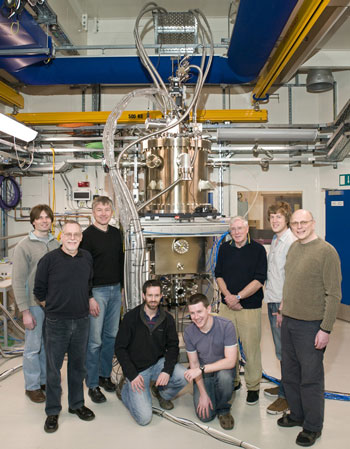| Aug 24, 2012 |
Physicists join search for hidden magnetic states
|
|
(Nanowerk News) Physicists from the University of Southampton were among the first researchers to use the new high magnetic-field beamline at Diamond Light Source, the UK’s national synchrotron facility, to search for ‘hidden magnetic states’. If found, they will provide important confirmation of a theoretical model, which could have important applications in magnetic data storage.
|
|
Diamond’s new I10 Beamline for Advanced Dichroism Experiments (BLADE) beamline, which has 300,000 times the strength of the earth’s magnetic field, is providing them with the tools for the search. The beamline was developed through a partnership of several UK universities, including Southampton.
|
 |
| Peter de Groot (2nd left) and his team at Diamond Light Source.
|
|
A team led by Professor Peter de Groot, from Southampton’s Quantum, Light and Matter Group, consisting of physicists from the University of Southampton, the Clarendon Laboratory at Oxford and the Magnetic Spectroscopy Group at Diamond, is looking for ‘hidden magnetic states’ in a type of magnet that has been identified as an ideal candidate for data storage. The composition of this magnetic film material is such that it provides sufficient energy barriers to prevent thermally-activated data loss, with the potential to relieve the present limit on the storage density of hard disk drives.
|
|
Professor Graham Bowden from the University of Southampton explains: “We are using the 14 Tesla Oxford Instruments superconducting magnet on the BLADE beamline to study exchange-spring magnets. Our exchange-spring magnetic multilayers consist of alternating hard and soft-magnetic layers, in which the magnetisation arranges in spring-like magnetic nanostructures. Such magnets offer additional flexibility in optimising magnetic properties, with possibilities for superior data storage capabilities.
|
|
“So far we have identified at least three different classes of exchange-spring magnetic states. Being able to manipulate these states will mean that more than one piece of information can be stored at a given site. There are also ‘hidden magnetic states’. Accessing these new exchange-spring states and their switching processes would be an exciting breakthrough in the field of novel magnetic store media. It will provide important confirmation of the theoretical model developed for exchange spring magnets at Southampton.”
|
|
The Southampton team has been allocated further beam time to continue this research in early 2013.
|
|
Senior Beamline Scientist on BLADE, Dr Peter Bencok adds: “The first results on the new high-field superconducting magnet represent an important milestone, not only for the beamline, but for the whole of Diamond. Its magnetic field of 14 Tesla is about six times stronger than the saturation magnetization of high purity iron. This beamline also enables studies at the lowest temperature at Diamond of 300 milliKelvin – a chilling minus 272.85 degrees Celsius. The team has worked hard to achieve this milestone and we are really pleased to see that BLADE is playing a key role in important new physics.”
|

